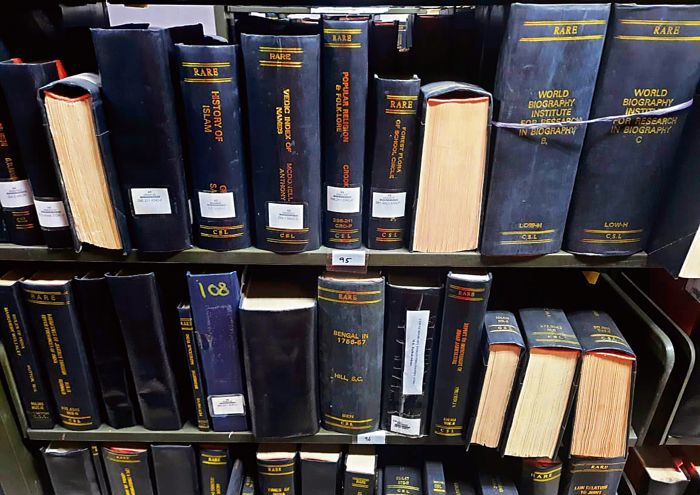Central Secretariat Library a repository of historical treasures
Anshita Mehra
New Delhi, June 23
Tucked away in the heart of New Delhi, the Central Secretariat complex is not only the abode of Union Government offices but is also steeped in history. Few are aware that the compound houses the captivating Central Secretariat Library (CSL), which has been a witness to India’s history since 1922.
Situated in the iconic Shastri Bhawan, this library has diligently preserved numerous government records since their inception. Serving as a sanctuary for research students and UPSC aspirants, it accommodates 5,500 rare books, settlement reports, civil reports, Acts of Parliament, census and annual reports. This repository beckons researchers, scholars and history enthusiasts to delve into India’s intricate administrative and historical landscape.
Its significance is elevated by the inclusion of settlement reports, offering crucial insights into the evolution of the nation’s geographical boundaries. Civil reports, which detail the role of various IAS officers, further cements its status as a repository of administrative history. The Acts of Parliament housed at the CSL stand as foundational legal documents that have shaped the trajectory of the nation’s governance.
Moreover, the census reports within the CSL, meticulously categorised by gender, caste and age, serve as invaluable reservoirs for demographic studies. They provide detailed insights into India’s population dynamics over time.
Established in 1891 as the Imperial Library, the CSL holds the distinction of being one of the nation’s oldest libraries, with a narrative intertwined with the ebb and flow of India’s growth. The library made a significant transition from Kolkata to Delhi in 1969, aligning with the capital’s shift.
It officially assumed the title of the Central Secretariat Library in March 1948, a name reflective of its pivotal role in preserving and disseminating knowledge. The extensive collection of government gazettes, dating back to 1922, serves as a captivating time capsule, documenting the decisions and proclamations of the Indian Government over the years. The most recent physical copy of the gazette in the library dates back to 2015, as subsequent editions have been exclusively published in soft copy format.
The influence of the library even extends to courtroom proceedings, with its gazettes frequently cited as reservoirs of legal precedents. Besides, the CSL has taken a step towards modernisation by digitising its collection, a process facilitated through the Indian Culture Portal (ICP), managed by IIT-Bombay.
Despite the push for digitisation, the CSL retains its status as the primary repository for these physical records, boasting the most comprehensive collection on the aforementioned subjects. However, it is not merely a repository for paperwork; it stands as a sanctuary for rare books and historical manuscripts that narrate tales of bygone eras.
A 1702 French piece is the oldest book in the library — Recueil des Voyages qui ont servi à L’établissement et aux progrès de la Compagnie des Indes Orientales (Collection of Voyages that have served the establishment and progress of the East India Company). Plans are underway to translate this piece, to enable more readers to read this piece.
The CSL boasts a collection of over 5,000 rare book titles, originating from the Imperial Secretariat Library, primarily focusing on Indian history during the 18th, 19th and the early 20th century. Among these treasures is the Select Specimens of the Theatre of the Hindus by Horace Hayman Wilson, published by Trubner in London in 1871. This book offers valuable insights into the rich theatrical traditions of Hinduism.
Another notable work, History of The Indian Administration of Lord Ellenborough, published in 1874 by Colchester, provides a glimpse into the administration of Lord Ellenborough during British rule in India. The compilation of letters written by Lord Ellenborough to the Queen, along with correspondence with the Duke of Wellington, sheds light on the political and administrative affairs in India during that period.
Published in 1862, Works by the late Horace Hayman Wilson reflects Wilson’s profound engagement with the Hindu religion. As an assistant surgeon in the East India Company, Wilson developed a keen interest in Hindu literature, antiquities, history and religious systems.
Another noteworthy publication from 1872, A Comprehensive History of India, Civil, Military, and Social, From the First Landing of the English to the Suppression of the Sepoy Revolt: Including an Outline of the Early History of Hindoostan, by Henry Beveridge, covers a broad spectrum of Indian history from the arrival of the Englishmen in India to the Sepoy Revolt in 1857.
Was established in 1891
- The CSL was established in 1891 as the Imperial Library.
- It officially became the Central Secretariat Library in March 1948, and was moved from Kolkata to Delhi in 1969.
- The extensive collection of government gazettes, dating back to 1922, acts as a captivating time capsule, capturing the decisions and proclamations of the Indian government over the years.
- The last physical copy of the gazette stored in the library hails from 2015. Thereafter the gazettes have only been published as soft copies.









